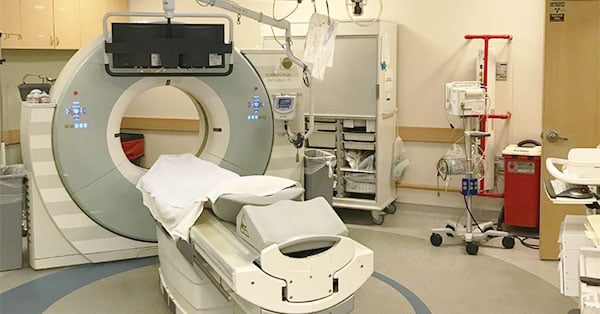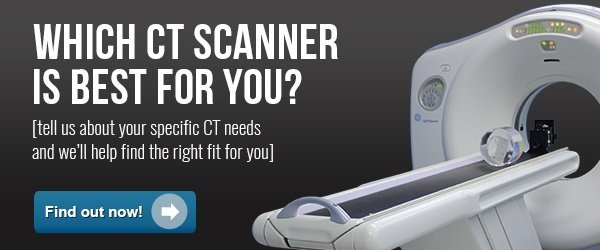
While Siemens is busy marketing and selling their latest CT scanners, the "SOMATOM go" series, the secondary CT market is seeing an increasing availability of units from the previous generation: the Definition series.
If you're looking for a previously-owned CT, a system from the Definition series could be a good fit for your needs. But which one should you choose? Because there are so many details packed into the name of each of them, we're going to take the next few paragraphs to clarify what makes each Definition scanner different from the other members of its family.
Definition DS
The Definition Dual Source (DS) was the first model in the Definition series and is quite different from the rest. The DS has two Straton MX tubes- hence, dual-source. It has incredible image quality and fast scan times. Some call it a 128-slice CT, but technically it comes in 64 x 2 or 32 x 2 varieties. To clarify: while a dual-source CT scanner is capturing twice as many anatomical slices as a single source, those slices comprise two data sets taken from the same coverage area, making dual-source technology a benefit to scan times rather than image resolution.
The major drawback of the two-tube configuration is the service cost involved in replacing two proprietary tubes. At about $120,000 (over $200,000 from the OEM) for each Straton MX, a service contract for a Definition DS is not for the faint of heart.
Definition AS/AS+
The Definition Adaptive Scanning (AS) comes in 20, 40, or 64-slice varieties, or it can come as a Definition AS+, which is a 128-slice scanner. Regardless of the slice count, the hardware across the series is nearly identical. The concept behind the AS sub group was a unique one: if you can only afford a 20-slice or 40-slice scanner right now, a simple field upgrade at any time can move you up to a 64 or 128-slice.
Definition AS scanners are the most popular among the Definition family, as they have a lower cost of ownership owing to their single source (one tube) and upgrade path. The tube used in Definition AS machines is a Straton MXP-46. Though they are different from the tubes found in the Definition DS (i.e. not interchangeable) Straton MXP tubes are still $90,000 - $120,000 (over $200,000 from the OEM) to replace. But at least there's only one of them, right?
Definition Flash
The Siemens Definition Flash is similar to the Definition DS with two tubes, but it also has two 128-slice detectors, making it, like the DS, what some would call a de facto 256-slice scanner. This makes for some of the fastest scans on the market (0.28 second rotation) and incredible resolution.
Like the DS, the drawback to the Flash's incredible speed and resolution is its service costs. With two tubes, upkeep on a Flash can run very much on the steep side.
Definition Edge
The Siemens Definition Edge is a single source, 128-slice scanner that offers the same 0.28 second rotation as the Flash. It achieves this, in part, with Siemens' TwinBeam Dual Energy technology. This allows the Edge to acquire two data sets without an increase in radiation dose. In terms of upkeep costs, a user can expect the Edge to fall in the same tier as its single-source brethren from the AS subgroup.
The Takeaway
Hopefully, the distinctions above will give you some clarity as you approach scanners from the Siemens Definition series. Whichever model you may be considering in particular, you can be certain the technology is impressive, leading, and the service costs will tend toward the higher end of the spectrum. As always, striking the balance between clinical capability and operating expense will come down to your facility's individual circumstances.

Paul Crawford
Paul Crawford is the Vice President of Equipment Solutions at Block Imaging. Paul connects with healthcare facilities across the world to offer CT solutions and manages the wholesale sales team. When Paul is not helping customers with their CT needs, he enjoys spending time with his family, watching MSU sports, and CrossFit.






